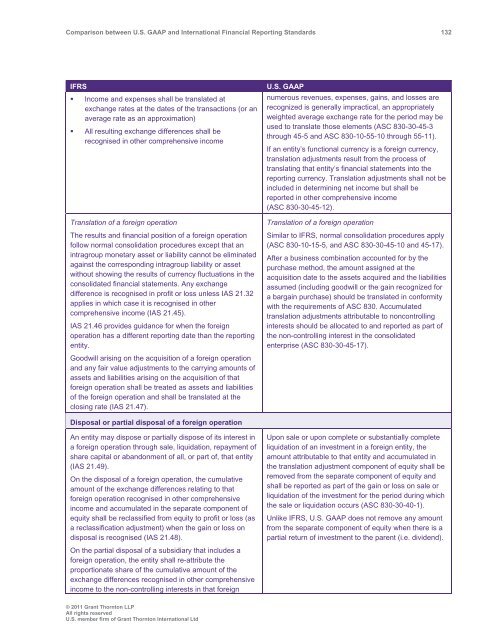Comparison between U.S. GAAP and International ... - Grant Thornton
Comparison between U.S. GAAP and International ... - Grant Thornton
Comparison between U.S. GAAP and International ... - Grant Thornton
Create successful ePaper yourself
Turn your PDF publications into a flip-book with our unique Google optimized e-Paper software.
<strong>Comparison</strong> <strong>between</strong> U.S. <strong>GAAP</strong> <strong>and</strong> <strong>International</strong> Financial Reporting St<strong>and</strong>ards 132<br />
IFRS<br />
• Income <strong>and</strong> expenses shall be translated at<br />
exchange rates at the dates of the transactions (or an<br />
average rate as an approximation)<br />
• All resulting exchange differences shall be<br />
recognised in other comprehensive income<br />
Translation of a foreign operation<br />
The results <strong>and</strong> financial position of a foreign operation<br />
follow normal consolidation procedures except that an<br />
intragroup monetary asset or liability cannot be eliminated<br />
against the corresponding intragroup liability or asset<br />
without showing the results of currency fluctuations in the<br />
consolidated financial statements. Any exchange<br />
difference is recognised in profit or loss unless IAS 21.32<br />
applies in which case it is recognised in other<br />
comprehensive income (IAS 21.45).<br />
IAS 21.46 provides guidance for when the foreign<br />
operation has a different reporting date than the reporting<br />
entity.<br />
Goodwill arising on the acquisition of a foreign operation<br />
<strong>and</strong> any fair value adjustments to the carrying amounts of<br />
assets <strong>and</strong> liabilities arising on the acquisition of that<br />
foreign operation shall be treated as assets <strong>and</strong> liabilities<br />
of the foreign operation <strong>and</strong> shall be translated at the<br />
closing rate (IAS 21.47).<br />
U.S. <strong>GAAP</strong><br />
numerous revenues, expenses, gains, <strong>and</strong> losses are<br />
recognized is generally impractical, an appropriately<br />
weighted average exchange rate for the period may be<br />
used to translate those elements (ASC 830-30-45-3<br />
through 45-5 <strong>and</strong> ASC 830-10-55-10 through 55-11).<br />
If an entity’s functional currency is a foreign currency,<br />
translation adjustments result from the process of<br />
translating that entity’s financial statements into the<br />
reporting currency. Translation adjustments shall not be<br />
included in determining net income but shall be<br />
reported in other comprehensive income<br />
(ASC 830-30-45-12).<br />
Translation of a foreign operation<br />
Similar to IFRS, normal consolidation procedures apply<br />
(ASC 830-10-15-5, <strong>and</strong> ASC 830-30-45-10 <strong>and</strong> 45-17).<br />
After a business combination accounted for by the<br />
purchase method, the amount assigned at the<br />
acquisition date to the assets acquired <strong>and</strong> the liabilities<br />
assumed (including goodwill or the gain recognized for<br />
a bargain purchase) should be translated in conformity<br />
with the requirements of ASC 830. Accumulated<br />
translation adjustments attributable to noncontrolling<br />
interests should be allocated to <strong>and</strong> reported as part of<br />
the non-controlling interest in the consolidated<br />
enterprise (ASC 830-30-45-17).<br />
Disposal or partial disposal of a foreign operation<br />
An entity may dispose or partially dispose of its interest in<br />
a foreign operation through sale, liquidation, repayment of<br />
share capital or ab<strong>and</strong>onment of all, or part of, that entity<br />
(IAS 21.49).<br />
On the disposal of a foreign operation, the cumulative<br />
amount of the exchange differences relating to that<br />
foreign operation recognised in other comprehensive<br />
income <strong>and</strong> accumulated in the separate component of<br />
equity shall be reclassified from equity to profit or loss (as<br />
a reclassification adjustment) when the gain or loss on<br />
disposal is recognised (IAS 21.48).<br />
On the partial disposal of a subsidiary that includes a<br />
foreign operation, the entity shall re-attribute the<br />
proportionate share of the cumulative amount of the<br />
exchange differences recognised in other comprehensive<br />
income to the non-controlling interests in that foreign<br />
Upon sale or upon complete or substantially complete<br />
liquidation of an investment in a foreign entity, the<br />
amount attributable to that entity <strong>and</strong> accumulated in<br />
the translation adjustment component of equity shall be<br />
removed from the separate component of equity <strong>and</strong><br />
shall be reported as part of the gain or loss on sale or<br />
liquidation of the investment for the period during which<br />
the sale or liquidation occurs (ASC 830-30-40-1).<br />
Unlike IFRS, U.S. <strong>GAAP</strong> does not remove any amount<br />
from the separate component of equity when there is a<br />
partial return of investment to the parent (i.e. dividend).<br />
© 2011 <strong>Grant</strong> <strong>Thornton</strong> LLP<br />
All rights reserved<br />
U.S. member firm of <strong>Grant</strong> <strong>Thornton</strong> <strong>International</strong> Ltd
















